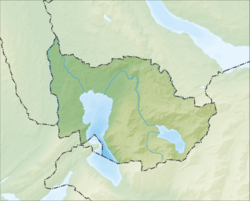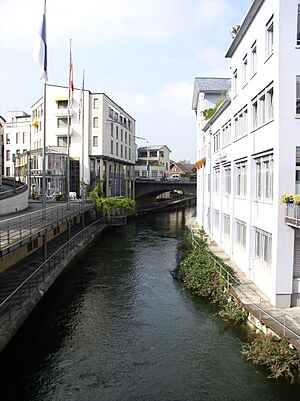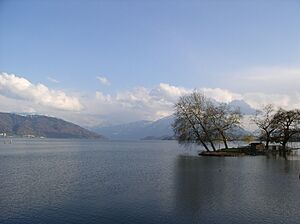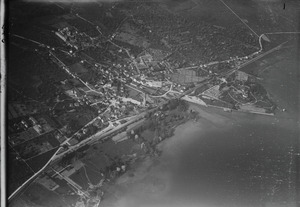Cham, Switzerland facts for kids
Quick facts for kids
Cham
|
||
|---|---|---|
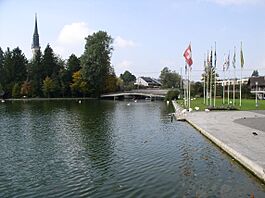 |
||
|
||
| Country | Switzerland | |
| Canton | Zug | |
| Area | ||
| • Total | 17.73 km2 (6.85 sq mi) | |
| Elevation | 420 m (1,380 ft) | |
| Population
(Dec 2020 )
|
||
| • Total | 17,042 | |
| • Density | 961.20/km2 (2,489.5/sq mi) | |
| Postal code |
6330
|
|
| Surrounded by | Hünenberg, Knonau (ZH), Maschwanden (ZH), Risch, Steinhausen, Zug | |
| Twin towns | Cham (Germany) | |
Cham is a town in the canton of Zug, Switzerland. It is a municipality, which means it has its own local government.
Contents
Where is Cham Located?
Cham is found on the northern shore of Lake Zug. It is about 5.5 kilometers (3.4 miles) northwest of Zug, the capital city of the canton.
Around Cham, you'll find Steinhausen to the east and Hünenberg to the west. Lake Zug is to the south. To the north are Maschwanden and Knonau, which are in the Canton of Zürich.
The town covers an area of about 19.82 square kilometers (7.65 sq mi). The train station is 418 meters (1,371 ft) above sea level. The highest point in Cham is 468 meters (1,535 ft) above sea level.
Cham is located where the Lorze river flows into Lake Zug. The town has two main parts, Kirchbühl and Städtli, on both sides of the river. Cham also includes smaller villages like Enikon, Lindencham, Friesencham, Hagendorn, Rumentikon, Niederwil, Oberwil, and Bibersee.
Most of Cham's land, about 63.3%, is used for farming. Forests cover 13.2% of the area. About 21.7% of the land has buildings or roads. The rest, 1.8%, is made up of rivers or other natural areas.
A Look Back: Cham's History
People have lived along the shores of Lake Zug for at least 6,000 years. Many ancient discoveries have been made in Cham. For example, in the village of Oberwil, signs of settlements from the middle and late Bronze Age have been found.
In 1944–45, a large and special watermill from Roman times was discovered in Hagendorn village. It had many waterwheels. A Roman warehouse from the same period was also found in Heiligkreuz village.
The name "Cham" means "village." It refers to a large settlement of the Celtic people that once existed on Lake Zug's shore. After the Western Roman Empire fell, the Alamanni people also settled here.
The town was first mentioned in writing on April 16, 858. King Louis the German gave Cham to his daughter, Hildegard. She was the abbess (head nun) of the Fraumünster Abbey in Zürich. Over the next few centuries, different nobles and officials managed the town.
In 1360, Cham was given a special document called a charter. This charter allowed the town to hold a market and accept new citizens. Charles IV granted this charter to Gottfried von Hünenberg, who ruled the city at the time.
The Habsburgs wanted to keep their power in the area. So, they bought part of Cham in 1366 and fully owned it by 1370. However, after the Habsburgs lost the Battle of Sempach in 1386, Cham was taken over by Zug and Schwyz. Cham remained under the control of Zug until the French invasion in 1798.
In the 16th century, a preacher named Jost Müller tried to bring the Reformation (a religious movement) to Cham, but he was not successful.
After the French invaded Switzerland in 1798, Cham finally became an independent town. People still paid some taxes to Zug until 1816, and the last tax ended in 1872.
In the second half of the 1800s, Cham grew rapidly due to new factories. The population doubled between 1850 and 1880. In 1950, the town created its first plan for building and growth. This plan aimed to keep the town's unique character and protect the parkland along the lake. In 1991, Cham won the Wakker Prize for protecting its old buildings. By 1990, Cham was the third-largest city in the canton of Zug.
Who Lives in Cham?
Cham has a population of about 17,020 people. As of December 2008, nearly 20% of the people living in Cham were from other countries. Over the last 10 years, the number of people living in Cham has grown by 14%.
Most people in Cham (85.7%) speak German. Serbo-Croatian is the second most common language (3.1%), followed by Italian (1.9%).
In the 2007 federal election, the most popular political party was the SVP. They received 31.3% of the votes. Other popular parties were the CVP (22.2%), the FDP (18.2%), and the Green Party (17.8%).
About 76.4% of adults in Cham (aged 25–64) have completed higher education. This means they went to a university or a specialized college.
Here's how Cham's population has changed over time:
| Year | People |
|---|---|
| 1771 | 839 |
| 1850 | 1,321 |
| 1888 | 3,140 |
| 1900 | 2,025 |
| 1950 | 5,486 |
| 1970 | 8,209 |
| 1991 | 11,091 |
| 2000 | 13,145 |
| 2005 | 13,791 |
| 2006 | 13,730 |
| 2007 | 13,981 |
| 2013 | 15,020 |
| 2018 | 16,884 |
Cham's Weather
Cham typically has rain for about 136 days each year. On average, it gets about 1,147 millimeters (45.2 inches) of rain. June is the wettest month, with about 144 millimeters (5.7 inches) of rain over 13.5 days. February is the driest month, with about 69 millimeters (2.7 inches) of rain over 13.5 days.
Things to See and Do in Cham
Cham is a small town with many helpful services. It has its own medical clinic, schools for younger and older students, and kindergartens. There are also public green spaces and sports facilities that can be used all year.
Visitors and residents can find hotels, a congress hall for meetings, and churches (Roman Catholic and Reformed). Cham also has a marina for boats and a beautiful castle called St. Andreas. The church of St. James is an old building from the 1700s, with a tall tower from the 1400s. You can also enjoy many local and international foods at the town's restaurants.
Important Historical Sites
Cham is home to several important Swiss heritage sites. These include:
- The Eslen, which was a Neolithic (New Stone Age) settlement by the lake.
- The church and Cistercian convent at Frauenthal.
- The Castle of St. Andreas.
- Two important buildings in the old part of the city.
- The old brickyard.
Getting Around Cham
Cham is about 5.5 kilometers (3.4 miles) from Zug. It is also centrally located between Luzern (25 km or 16 mi away) and Zürich (32 km or 20 mi away).
The Swiss Federal Railways train line, which goes from Luzern to Zürich, sometimes stops in Cham. The E41 highway also passes close to Cham. You can also reach the city by bus from Zug, and in the summer, you can take a boat.
Cham's Economy and Jobs
Cham has a low unemployment rate of 2.05%. In 2005, about 206 people worked in farming, with 68 businesses in this area. About 2,151 people worked in factories and manufacturing, with 179 businesses. The largest number of people, 4,900, worked in service industries, with 783 businesses.
For most of Cham's history, farming and small factories were the main ways people earned money. The Lorze River was always important for the town's growth. The first watermill in Cham was built in 1279. Around 1641, a factory for dyeing and bleaching clothes was built along the river.
In 1657, a paper mill was built. It started using machines in the 1720s and had its first paper machine in 1840. After joining with other companies, this factory became the first Swiss wood pulp factory. In the 1900s, it became Papierfabrik Cham AG, the biggest company in Cham.
In 1863, a company that spun cotton and wove fabric opened in Cham. After a big fire in 1888, the factory closed. However, the buildings where child workers used to live are now a children's home.
In 1864, Cham was connected to the Zürich-Lucerne train line. In 1866, the American Page family started the Anglo-Swiss Condensed Milk Company in Cham. They used the new train line to transport their products. The company first made condensed milk, but soon made other milk products too. In 1905, it joined with another company to form Nestlé, which is a very famous food company today.
Nestlé grew quickly. By 1907, they had over 1,000 milkmen in 44 locations. In 1913, a disagreement about money led to a strike by the milkmen, which made the company weaker. After World War I, the company had money problems and started to close down production in Cham.
In 1905, one-third of Cham's population worked in farming, and half worked in factories. By 1955, nearly two-thirds of the people worked in factories. Later, factory jobs decreased, but because Cham is in a good location and has low taxes, service industries grew. In 2001, 80% of businesses and 58% of jobs were in service industries.
Sports in Cham
SC Cham is the town's football (soccer) club.
Famous People from Cham
- Victor Villiger (1868 in Cham – 1934) a chemist who discovered the Baeyer-Villiger oxidation.
- Robert Schiess (1896 in Cham – 1956) a Swiss painter and a member of the Pontifical Swiss Guard.
- George Page (1910 in Cham - 2001) an American alpine skier who competed in the 1936 Winter Olympics.
- Grégory Rast (born 1980 in Cham) a Swiss former professional road bicycle racer.
- Cora Huber (born 1981 in Cham) a Swiss bobsledder who competed at the 2006 Winter Olympics.
- Priska Doppmann (born 1971 in Cham) a Swiss road racing cyclist who competed at the 2008 Summer Olympics.
- Martin Elmiger (born 1978 in Hagendorn) a Swiss former road racing cyclist and Swiss National Road Race champion multiple times.
Images for kids
See also
 In Spanish: Cham (Zug) para niños
In Spanish: Cham (Zug) para niños




